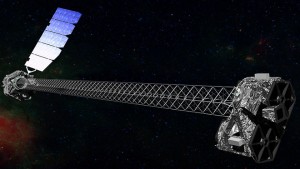
This morning NASA’s Nuclear Spectroscopic Telescope Array (NuSTAR) launched over the central Pacific Ocean at 9 a.m. PDT (noon EDT). It’s main objective is to unveil secrets of black holes using a unique set of eyes to see high-energy X-ray light from the cosmos.
“We all eagerly await the launch of this novel X-ray observatory,” said Paul Hertz, NASA’s Astrophysics Division Director. “With its unprecedented spatial and spectral resolution to the previously poorly explored hard X-ray region of the electromagnetic spectrum, NuSTAR will open a new window on the universe and will provide complementary data to NASA’s larger missions, including Fermi, Chandra, Hubble and Spitzer.”
The observatory began its journey aboard a L-1011 “Stargazer” aircraft, operated by Orbital Sciences Corporation, Dulles, Va. NuSTAR was strapped to the belly of the airplane, together with a Orbital’s Pegasus XL rocket. The airplane left the Kwajalein Atoll in the central Pacific Ocean one hour before launch. At 9:00:35 a.m. PDT (12:00:35 p.m. EDT) the Pegasus XL rocket, with its NuSTAR payload, was dropped, and after a five second free-fall it fired its first-stage motor propelling it towards its destination.
About 13 minutes after the rocket dropped, NuSTAR separated from the rocket, reaching its final low Earth orbit. The first signal from the spacecraft was received at 9:14 a.m. PDT (12:14 p.m. EDT) via NASA’s Tracking and Data Relay Satellite System.
“NuSTAR spread its solar panels to charge the spacecraft battery and then reported back to Earth of its good health”, said Yunjin Kim, the mission’s project manager at NASA’s Jet Propulsion Laboratory in Pasadena, Calif. “We are checking out the spacecraft now and are excited to tune into the high-energy X-ray sky.”
The mission includes a 33-foot (10-meter) mast with a unique telescope design, which was folded up in a small canister during launch. In about seven days, engineers will command the mast to extend, enabling the telescope to focus properly. About 23 days later, science operations are expected to begin.
In addition to black holes and their powerful jets, NuSTAR will study a host of high-energy objects in our universe, including the remains of exploded stars; compact, dead stars; and clusters of galaxies. The mission’s observations, in coordination with other telescopes such as NASA’s Chandra X-ray Observatory, which detects lower-energy X-rays, will help solve fundamental cosmic mysteries. NuSTAR also will study our sun’s fiery atmosphere, looking for clues as to how it is heated.
NuSTAR Observatory Facts:
- Spacecraft Dimensions: 3.9 by 7.2 feet (1.2 by 2.2 meters) when stowed for launch; 3.9 by 35.8 feet (1.2 by 10.9 meters) after mast is extended in space.
- Weight (spacecraft bus and science instrument): 772 pounds (350 kilograms).
- Power: solar arrays capable of generating 729 Watts of power.
- Science instrument: telescope consisting of two co-aligned high-energy X-ray optic units; two shielded detectors; and a connecting 33-foot (10-meter) mast to be deployed in space.
- Instrument Energy Range: Detects X-rays with energies between 5 and 80 kilo electron volts (keV).
- Stowed instrument Dimensions: 3.9 by 5.3 feet (1.2 by 1.6 meters).
- Instrument Weight: 377 pounds (171 kilograms).
